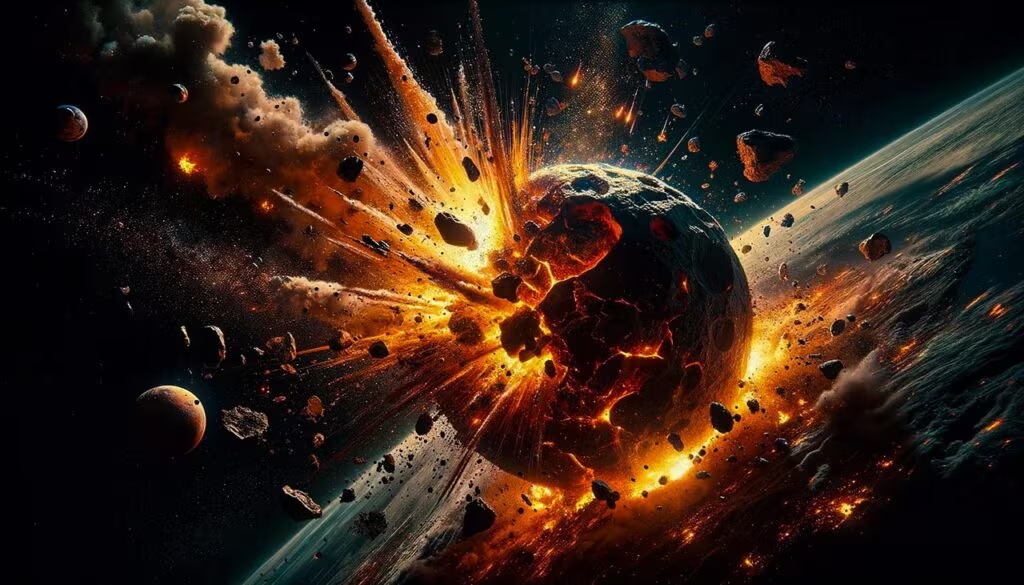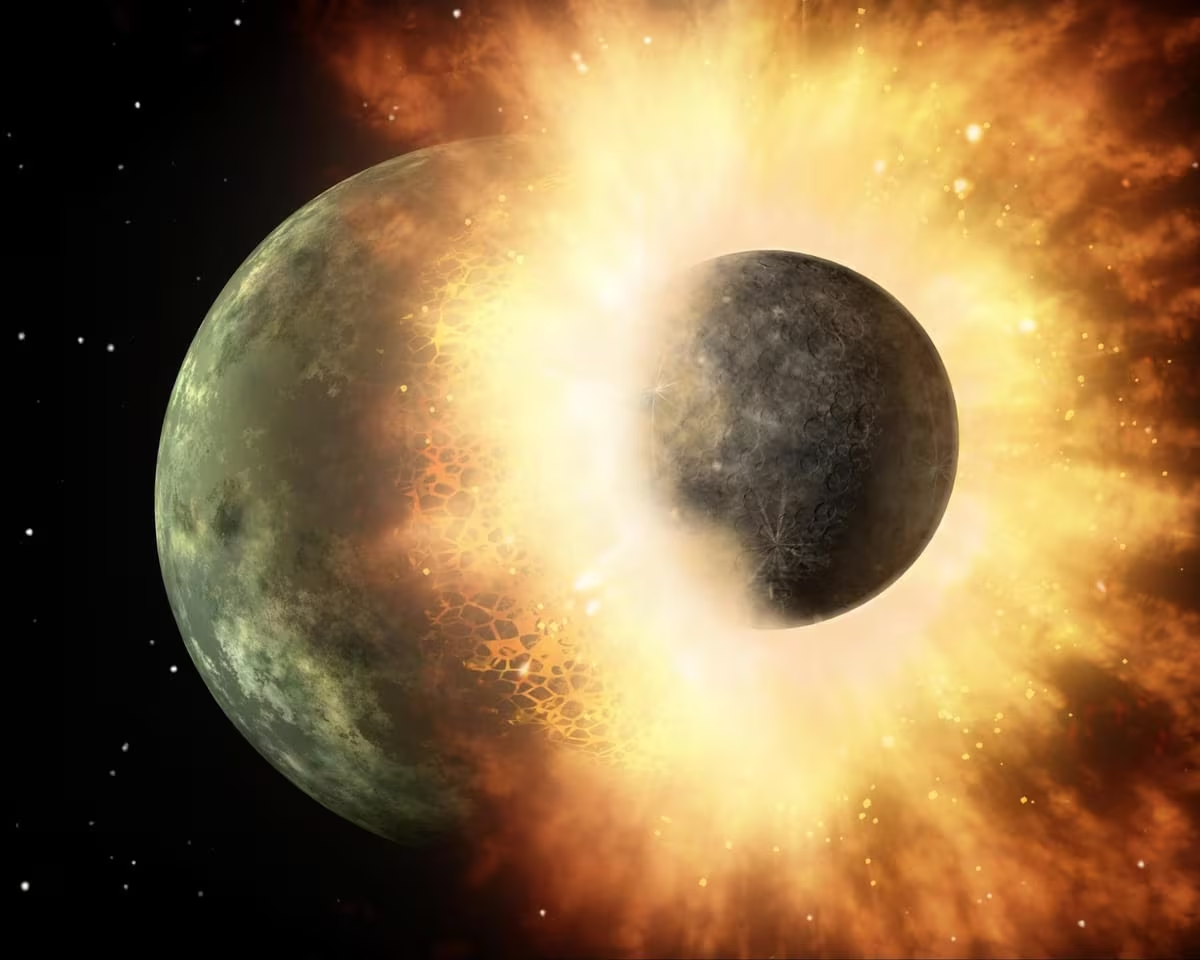Unlocking the Mystery of the Moon’s Violent Birth
For decades, the prevailing scientific consensus regarding the Moon’s formation has centered on the Giant Impact Hypothesis (GIH): a catastrophic collision between the early Earth and a Mars-sized protoplanet named Theia, approximately 4.5 billion years ago. While this theory explains the angular momentum and the sheer scale of the event, a critical piece of the puzzle—the identity and ultimate fate of Theia—has remained elusive.
New, groundbreaking research has provided compelling evidence suggesting that the remnants of this lost planet are not scattered across the solar system, but are instead hidden deep within our own world. Scientists now propose that the mysterious, massive blobs of dense material found at the boundary of Earth’s core and mantle are, in fact, the sunken material of Theia.
This discovery, which links the Moon’s origin to anomalies deep beneath our feet, fundamentally reshapes our understanding of planetary formation and the violent history of the Earth-Moon system.
The Giant Impact Hypothesis and the Isotopic Problem
The Giant Impact Hypothesis posits that Theia struck the proto-Earth, vaporizing vast amounts of crust and mantle material from both bodies. This ejected debris then coalesced in orbit to form the Moon. The theory is robust, yet it faced a major challenge known as the isotopic similarity problem.
Planetary scientists use isotopic signatures—the ratios of different atomic isotopes—as a kind of planetary DNA. Generally, objects formed in different regions of the solar system have distinct isotopic signatures. Standard models predicted that the Moon, formed primarily from Theia’s material, should have a different isotopic fingerprint than Earth.
However, samples brought back by the Apollo missions revealed that the Moon’s isotopic signature is nearly identical to Earth’s mantle. This required increasingly complex and unlikely scenarios to explain, such as a high-energy, high-angular-momentum impact that completely mixed the two planets, or that Theia somehow formed in the exact same orbital neighborhood as Earth.

The Search for Theia’s Material
If the Moon was mostly Earth material, where did Theia go? The new research, often associated with studies published in high-profile journals like Nature, offers a definitive answer: Theia’s denser, iron-rich material and unique mantle components sank into the Earth’s interior immediately following the impact.
Theia’s Hidden Legacy: The LLSVPs
The key to unlocking Theia’s fate lies in two massive, dense structures located deep within Earth’s lower mantle, known as the Large Low-Shear-Velocity Provinces (LLSVPs). These structures, situated beneath Africa and the Pacific Ocean, are colossal—each is larger than a continent and several hundred kilometers thick. They are characterized by slower seismic wave speeds, indicating they are hotter and chemically distinct from the surrounding mantle material.
For years, the origin of the LLSVPs has been one of the biggest mysteries in geophysics. The new model proposes that these structures are the remnants of Theia’s mantle material that survived the impact and settled near the Earth’s core.
Key characteristics supporting the LLSVP-Theia link:
- Chemical Density: The LLSVPs are significantly denser than the surrounding mantle, consistent with material from a differentiated protoplanet that formed in a different part of the solar system.
- Thermal Isolation: Their high temperature suggests they have been isolated and chemically distinct since the earliest days of Earth’s history, resisting complete mixing with the rest of the mantle.
- Impact Dynamics: Simulations show that if Theia was chemically denser than the proto-Earth’s mantle, its material could have sunk rapidly and accumulated near the core-mantle boundary, forming the LLSVPs.
This theory elegantly solves the isotopic similarity problem. If the Moon was formed primarily from the ejected material of the Earth’s mantle, which was already mixed with a small fraction of Theia’s material, while the bulk of Theia’s unique material settled deep inside, it explains why the Moon and Earth’s surface share such similar isotopic signatures.

“The LLSVPs are essentially the graveyards of Theia’s mantle. This is the first time we have a physical, observable structure on Earth that we can directly link to the Moon-forming impact,” stated one of the researchers involved in the modeling.
Implications for Planetary Differentiation and Early Earth
The confirmation of Theia’s location has profound implications not just for lunar science, but for the entire field of planetary geophysics and the study of the early solar system.
1. Re-evaluating Planetary Differentiation
This finding suggests that planetary differentiation—the process by which dense materials sink to the core and lighter materials rise to the crust—was far more complex and incomplete than previously thought. The LLSVPs demonstrate that large volumes of foreign, chemically distinct material can survive a catastrophic collision and remain isolated for billions of years.
2. Understanding Earth’s Internal Dynamics
The LLSVPs play a crucial role in driving mantle plumes and volcanic activity today. Understanding their origin as Theia’s remnants provides a new lens through which to study plate tectonics, heat transfer, and the long-term evolution of Earth’s interior. The chemical differences in the LLSVPs could explain anomalies in the composition of certain volcanic rocks.
3. The Composition of Theia
By studying the seismic and chemical properties of the LLSVPs, scientists can now infer the original composition of Theia. Early analysis suggests Theia was likely richer in iron and titanium than the proto-Earth, which contributed to its higher density and ability to sink.

Key Takeaways: The New View of the Moon’s Origin
This research provides a satisfying and physically observable answer to one of astronomy’s most enduring questions. Here are the essential points for understanding this scientific breakthrough:
- Theia’s Location: The remnants of the protoplanet Theia are believed to be the Large Low-Shear-Velocity Provinces (LLSVPs), two massive, dense structures located deep in Earth’s lower mantle.
- Solving the Isotopic Problem: The Moon has an isotopic signature similar to Earth because it was formed primarily from Earth’s ejected mantle material, while Theia’s denser, chemically distinct material sank and was sequestered into the LLSVPs.
- Impact Dynamics: The model suggests that Theia was denser than previously assumed, allowing its material to survive the impact and settle near the core-mantle boundary.
- Geophysical Significance: The LLSVPs, now linked to the Moon’s formation, are critical drivers of Earth’s internal dynamics, including mantle plumes and heat flow.
Conclusion: A Complete Picture of Catastrophe
For the first time, the Giant Impact Hypothesis feels complete. We now have a plausible explanation not only for the Moon’s existence but also for the ultimate fate of the impactor that created it. Theia was not vaporized entirely or flung into deep space; it was absorbed, leaving its colossal, dense signature buried within the core of our planet. This finding underscores the violent, chaotic processes that defined the formation of the inner solar system and highlights how the deepest parts of Earth still hold the keys to its earliest history.
Original author: Becky Ferreira
Originally published: November 22, 2025
Editorial note: Our team reviewed and enhanced this coverage with AI-assisted tools and human editing to add helpful context while preserving verified facts and quotations from the original source.
We encourage you to consult the publisher above for the complete report and to reach out if you spot inaccuracies or compliance concerns.

